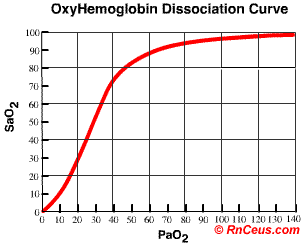OxyHemoglobin
Dissociation Curve
This curve describes the
relationship between available oxygen and amount of oxygen carried by hemoglobin.
- The horizontal axis is
Pa02, or the amount of oxygen available.
- The vertical axis is
SaO2, or the amount of hemoglobin saturated with oxygen.

- Once the PaO2 reaches
60 mm Hg the curve is almost flat, indicating there is little change in saturation
above this point.
- So, PaO2 of
60 or more is usually considered adequate.
- But, at less than
60 mm Hg the curve is very steep, and small changes in the PaO2
greatly reduce the SaO2.
-
The term
"affinity" is used to describe oxygen's attraction to hemoglobin
binding sites.
- Affinity changes
with:
- variation in
pH,
- temperature,
- CO2
and,
- 2,3,-DPG
- a metabolic
by-product which competes with O2 for binding sites.
- Traditionally the
curve starts with:
- pH at 7.4,
- temperature
at 37 Centigrade, and
- PaCO2
at 40.
- A left
shift will increase oxygen's affinity for hemoglobin.
- In a left shift
condition (alkalosis, hypothermia, etc.) oxygen will have a higher affinity
for hemoglobin.
- SaO2
will increase at a given PaO2, but more of it will stay on the hemoglobin
and ride back through the lungs without being used. This can result
in tissue hypoxia even when there is sufficient oxygen in the blood.
- A right
shift decreases oxygen's affinity for hemoglobin.
- In a right shift
(acidosis, fever, etc.) oxygen has a lower affinity for hemoglobin.
Blood will release oxygen more readily.
- This
means more O2 will be released to the cells, but it also means less
oxygen will be carried from the lungs in the first place.
© RnCeus.com

